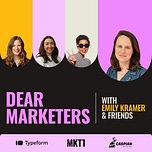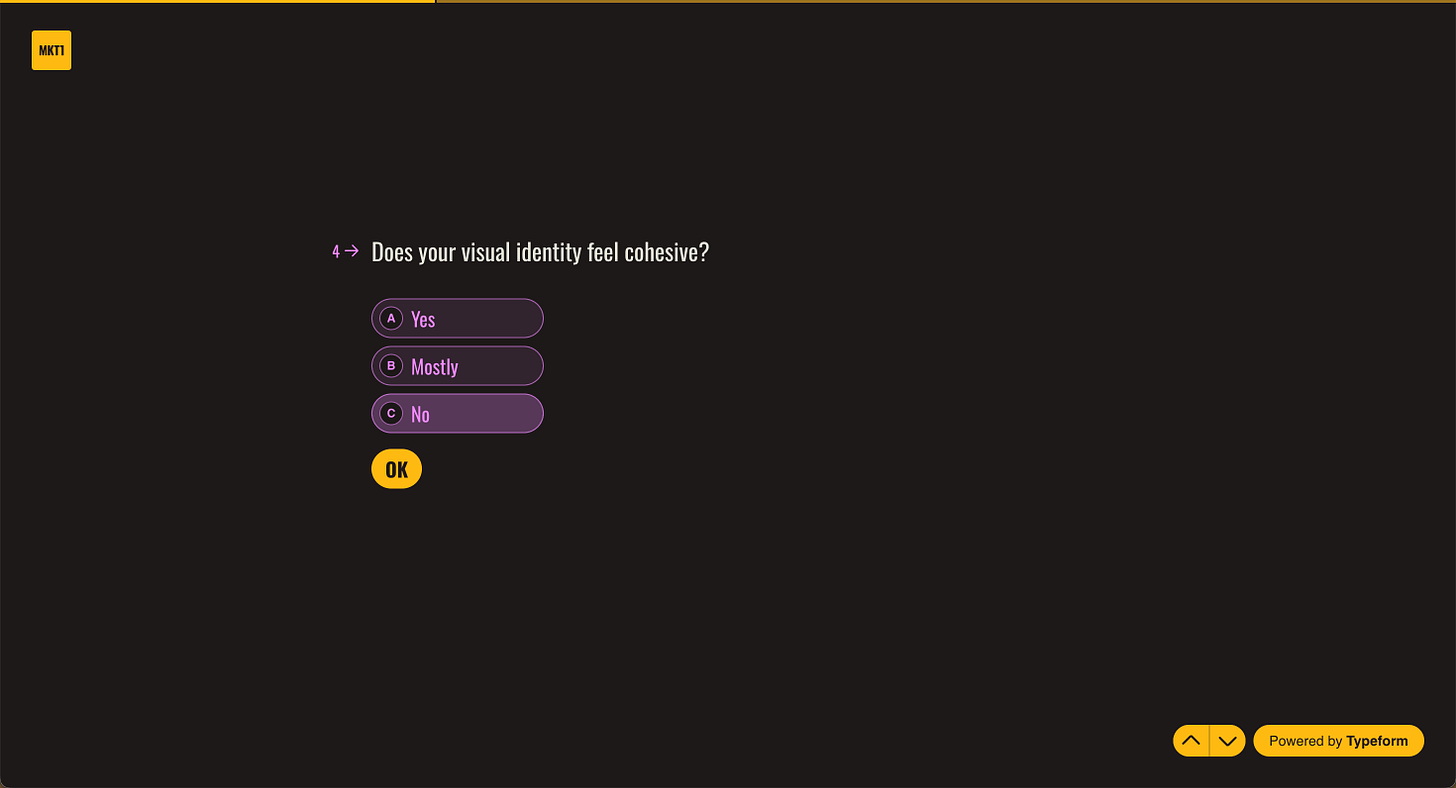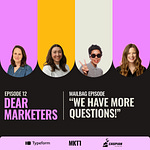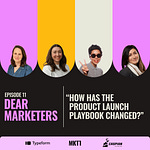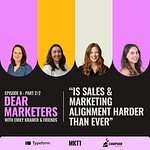🎙️ This free edition of MKT1 newsletter covers Season 1, Episode 7 of “Dear Marketers with Emily Kramer & Friends” podcast, brought to you by Typeform, Framer & 42 Agency.
Listen or watch the podcast on Spotify, Apple Podcasts, or YouTube. Plus read the full newsletter below for an even deeper dive on the topic. The newsletter is meant to augment the podcast, not just recap it.
Question: Dear Marketers…I have a bit of a chicken-and-egg question for you. When do you know it’s time for a website or homepage redesign, and when do you know it’s time for a full rebrand (if ever)? I feel like one often triggers the other, but it’s not always clear which should come first, or whether either is actually the right move.
– Kevin Branscum, Senior Director of Brand Marketing at Typeform
Dear Kevin and Marketers, Redesigns can quickly become time and money pits. Companies chase design trends, assume a rebrand is the only way to make a splash, or default to a redesign because a new CMO wants to make their mark. But unless something has fundamentally shifted in your business, brand, or strategy, you probably don’t need one. So, to answer your chicken-and-egg riddle:
Business changes should drive redesigns, not the other way around.
If you don’t have a solid brand foundation, a web redesign is going to be really hard to pull off. You’ll need to do the brand work first.
If your brand is sound, and your website just isn’t performing, is too hard to update, or feels visually inconsistent, you can likely get away with a web redesign or web refresh alone.
In this newsletter & podcast episode:
We cover the good and bad reasons to redesign, how to choose the right external partners to help you get it done, and common mistakes companies make in the process.
Jenny Thai, Head of Content at Vanta, Grace Erickson, VP of Revenue at Cocoon, and Kelsey Aroian, who’s led over 20 redesigns, join me to discuss:
Different types of redesigns to consider, and when each makes sense
How to choose between freelancers, studios, and agencies
The Dos and Don’ts of redesigns
Thanks to our Dear Marketers sponsors:
I vet each partner personally and these are genuine recommendations (even though yes, we do get paid for this).
Typeform: Add your brand details to Typeform’s “Brand Kit” -> create on brand, delightful forms every time. From no-code landing pages and NPS surveys to event registration forms embedded into your website, it’s easy with Typeform.
🎁Offer: Use code MKT1 to get 20% off their annual growth plan.
—
Framer: Building or redesigning your website? Use Framer, a no-code website builder for projects of any size. Apply to their new program for early-stage startups to get their Launch Plan free for a year—that’s $900 to design and ship your site.
🎁 Offer: Apply to Framer’s startup program or use code MKT1 to get 25% off a Basic, Pro, Startup or Scaleup yearly site.
—
42 Agency: Let 42 Agency handle the MOPS work your team avoids. From routing logic and fixing scoring to aligning Hubspot + Salesforce, 42 Agency is ready to help your B2B startup clean up and scale your ops.
🎁 Offer: Mention MKT1 to get a free 30 min MOPS support call-–they’ll troubleshoot an issue or audit your set up (available for first 10 startups).
Watch Episode 7 here, or keeping reading for the full newsletter!
You can also listen to the podcast on Spotify or Apple Podcasts.
Newsletter: To redesign or not to redesign?
I think the best reason for a brand redesign is that the story you're trying to tell, or who you’re trying to tell that story to, has changed fundamentally.
–Grace Erickson, Episode 7
How do you know if you have a good reason to redesign? Start by asking yourself these questions:
What specific business problem are we trying to solve? Has your market, product, audience, or GTM motion shifted? Is it about to?
Could we achieve our goals with a more targeted approach? Sometimes a focused campaign, messaging refresh, or updating key pages can deliver better ROI than a complete overhaul. If you can, do less.
Do we have the right internal resources to support this process? Redesigns require significant time from key stakeholders, not just for approvals but for strategic input. The more strapped you are internally, the more you’ll have to spend on external support.
Are we prepared to enforce the new brand system once it’s created? The value of a redesign diminishes rapidly if it’s not consistently implemented. And you don’t want to waste time and money on something you’re not set up to use.
All of this should inform the approach you take and the resources you invest in your redesign. So get some clarity on these questions early in the process with your stakeholders.
“The risk of a redesign is you can take a step back in like the equity you've built with your existing brand. So the reason for the redesign has to be. [00:34:00] Significant enough to make up for some loss of equity.”
-Grace, in the Episode 7 clip below
Part 1: How to do a brand or web redesign
There’s a bunch of different ways to approach a redesign. And no matter what you actually need, the project often snowballs very quickly (as Kevin mentioned). It’s not uncommon to start out thinking about a minor website update, and end up paying for a whole new brand.
You need to identify and agree on what type of project you are doing and what type of partner will best help you get it done before you go out and start picking agencies and working on the project.
So, we made you a cheat sheet. We named the various types of projects you can do in the diagram above. Note: The “rebrand” bar is longer on purpose—because a full rebrand usually means you’re doing everything below it too. That includes your logo, website, marketing assets, and often your product design.
Most startups, regardless of size, don’t have the right team in-house to fully execute a web or brand redesign. Redesigns of any kind are big, high-effort projects that create a temporary spike in workload. So if you do have everyone you need internally, you’re probably overstaffed on design and web development.
Plus, outside help doesn’t just give you more hands, they should help you zoom out and bring fresh, strategic thinking. The best agencies can even help mediate internal debates and align stakeholders. So when you, your founder, and the head of product all love different logos, someone is there to help you work it out.
But no matter who you hire—small studio or massive agency—there will always be work your team needs to do, even if the agency promises this won’t be the case.
How to decide what kind of redesign is right for you
A lot of the good reasons to do a web redesign boil down to: We’ve had a meaningful shift in our fuel and engine strategy and therefore our website needs to align with that.
–Jenny Thai, Episode 7
Redesigns are meaty, time-consuming, draining projects—not just in dollars, but in team time and momentum. Don’t go into it lightly. I’m speaking from lots of experience and redesign scars here! I’ve done every type of project mentioned in the diagram across my time at Ticketfly, Asana, Astro, and Carta. Plus, working with dozens of startups going through these projects since.
When embarking on a redesign or rebrand, the question to ask isn’t “How big should we go?” It’s typically “How small can we go and still fix the problem for the medium to long-term?”
Start by understanding the problem you are trying to solve. And only if there are meaningful changes to your business strategy, should you embark on a full rebrand.
Start by understanding the trigger. Is performance down (e.g., conversions, search rankings)? Is messaging misaligned with your sales motion? Are you expanding your audience or offerings? Each of these answers points to a different level of redesign:
If conversion is low, fixes to copy and flow can often solve the problem -> do a web content refresh
If your brand feels tired and isn’t flexing across all of your prospect and customer assets -> do a brand refresh and website redesign
If you are expanding to new audiences and products and your website and brand don’t seem to be up to the task -> consider a full rebrand.
Quiz! I even went a little overboard and made a fun Typeform quiz to help you ask the right questions and determine the right scope based on your specific signals. Available for paid subscribers here »
Choosing the right partner for your redesign
The success of your redesign is going to be evaluated through the lens of how effectively your team can use it on a day-to-day basis. You need someone who understands how to actually scale and operationalize this, making sure that people internally are trained on the new design system and have the right templates in place, so that you don’t have your designers making blog header images every day.
–Jenny Thai, Episode 7
What kind of external partner you need depends on your project scope and budget. The bigger the agency, typically the bigger the price.
But, you shouldn’t just choose based on budget. You need to look at the experience of your in-house team and augment that. Figure out if you need every single thing designed, or just templates that your in-house team can work from.
How much should you budget for a website or brand redesign?
It depends on your stage, scope and partner type you choose:
Early-stage startups can often refresh their website or lightly update their brand for $10K–$60k. A full brand and web overhaul might stretch to $100K.
Growth-stage startups typically spend $50–$200K, depending on scope
Late-stage companies often budget $150K–$500k+ for a site and brand overhaul
Larger budgets are usually driven by:
• Number of stakeholders
• Custom dev complexity
• Depth of brand strategy work
• Asset creation (copy, custom animations, custom photography)
For a breakdown of budgets by agency type, scope, and startup stage, check out our spreadsheet for paid subscribers »
Find an agency who complements your team
“If you go with an agency on the big side, they're gonna put their A team in front of you. But if you’re not one of their bigger clients, you might be getting the B, C, D team when it comes to the actual execution of the work. They're gonna put their A team's work in front of you as the example of the agency's agencies work and they're gonna give you references to the people that got the A team. And then you're gonna be left shocked when you have the D team.”
-Grace Erickson, Episode 7
Also, be aware that for any of the above options, they usually have a specialty (i.e. brand). Freelancers and even large agencies might be passable at other things (i.e. web design), but they are normally way better at one thing. So know where you have the biggest gap and need, and choose for that specialty. This might mean you use an agency for your rebrand, but partner with a freelance web designer and developer to apply the brand to the website.
When you go with a bigger agency:
Make sure you know exactly who you’ll be working with. Agencies usually put their “A” players in front of you during the sales process, but then send in the B or C team to do the actual work. If your budget is in the mid-range, you might get a better result from going with a smaller studio that can give you more attention.
Factor in lead times:
Freelancers, studios, and agencies all typically have significant lead time, 1 to 6 months—even for web redesigns. So, if you are considering doing a redesign anytime soon, don’t delay on getting that brief together and talking to agencies.
For more about choosing the right contractors and agencies, here’s a newsletter on the topic.
Part 2: Dos and don’ts of redesigns
🟢 DO get aligned, both internally and externally
“If you can’t make a good brief that explains what you need, your project is going to fall super flat, no matter the agency that you choose.”
–Kramer, Episode 7
The mistake: Not getting your internal team, cross-functional partners, founder, etc. on the same page about your redesign goals and how you’ll make decisions.
Variation on the mistake: You might have clear scope internally, but you fail to communicate it clearly to your external partners.
Both scenarios lead to extended timelines, increased scope and budget, and ultimately a final product no one’s happy with.
How to avoid it:
Create a clear and detailed brief for your project.
Our old standby, the GACCS brief, works really well here as a starting point—just modify it a bit to capture the specific needs of a creative project.
Get it approved internally first, and then turn it into an agency-facing RFP or creative brief for your external partners.
We have a new creative brief template for creating both your internal “GACCS” and expanding it to serve as an RFP & creative brief. Paid subscribers can access it here.
🔴 DON’T make it “vanilla”
“How do you avoid vanilla or chocolate ice cream as your brand or website? How do you avoid design by committee? Not only are you looking for someone who’s your brand therapist, but you’re actually looking for someone that can help broker those internal debates. A neutral third party is going to be really helpful.”
–Kramer, Episode 7
The mistake: Your redesigned brand or website looks like all the other B2B companies. This usually happens when there are too many stakeholders in the room (internal or external), or you don’t have a clear framework for making decisions—so you end up with something neutral that kind of pleases everyone and no one at the same time.
When your redesign is decided by committee, you’re going to end up with vanilla ice cream, just like everybody else.
As I shared in my last newsletter, a behind the scenes look at own content strategy, here are the ramifications of group think:
How to avoid it:
Choose a partner that can help prevent or resolve internal conflict. Look for someone who can bring an objective perspective and mediate internally.
You might also consider going with a smaller studio—big agencies bring tons of people to the table, which can exacerbate the problem.
Everyone who is providing real decision-making input, including those from the agency should fit in a small to medium size conference room, definitely not a board room.
Quick aside: Brand strategy work is actually pretty important
“A brand redesign without the foundation of the brand strategy is just a facelift. Your brand design is going to fall flat if it’s not built on the why.”
–Grace Erickson, Episode 7
Now this next part might seem silly and like something agencies do to increase the scope and price. I used to think this too, but I no longer do (and Kelsey and Grace swear by this work in the podcast as the secret to success).
A clear brand strategy helps you make decisions, both during the redesign process and into the future.
Brand strategy work includes things like: Your vision and mission, your brand narrative/story (which is broader than positioning), and brand attributes (aka brand values).
It’s really helpful to point to these things to settle internal debates, give constructive feedback, and provide context to anyone working on your brand in the future.
Here’s an example of how to use brand attributes in feedback conversations:
Let’s say you are reviewing a new homepage design.
Someone might say “It looks like every website right now” or “I’m so sick of that shade of purple.” That’s pretty unhelpful feedback.
But instead, you could say, “We are trying to be BOLD in everything we do and I think we can take more risks with design. Was there a version that was a bit bolder that you were afraid to show? If we were a consumer brand how would you make this bolder?”
The result? A comment that’s way more helpful and feels way less personal.
🟢 DO evolve and extend your brand before you redesign it
“I don’t think people think about brand evolution enough, because it’s hard. A lot of companies do rebrands when they don’t have a good campaigns motion, because big campaigns are an awesome way to shift gears and speak to an inflection point.”
–Kelsey Aroian, Episode 7
The mistake: Going all-in on a full rebrand just because you want to change your illustration style, one color, how you apply your brand system, and/or just “make a splash.”
How to avoid it:
There are plenty of opportunities to explore and evolve your brand without starting over from scratch.
New campaigns, new channels, and new product launches are all great opportunities to lean into a different primary color, bring in photography for the first time, add a new page or section template to your website, or do something even bolder.
This is a nice way to test something out and then potentially bring it into more of your brand and web assets over time.
And it can help you create a “moment” for your brand that feels new and different, without having to commit to a rebrand.
Example: Mercury, from fundraising video → homepage update
Mercury (where Devon, one of our dearest marketing cohosts works) recently launched a fundraising announcement and brand video using an evolved version of their existing brand system. They turned that video into a broader creative campaign, applying it across multiple touchpoints. And chances are, some of these new elements will influence their overall brand for a long time to come.
🔴 DON’T do the project like you would have 10 years ago (or even 5)
“Pretty soon you will be able to search for a product and buy it all from a ChatGPT-like or agentic workflow. At that point, I think your brand and website will still matter, but it's shifting. There will always be a role for the website, but I think we’ll see people restructuring and rebuilding their websites in new ways.”
–Kramer, Episode 7
The mistake: Planning your redesign with the “old rules” in mind.
You can now generate on-brand assets, pages, and even video and full websites quickly, often without needing a full design or dev team.
And soon we’ll be able to buy software through agents and LLMs directly, not just through websites. Buyers will describe their needs in tools like ChatGPT, get product recommendations, and sometimes even purchase, without ever visiting your homepage. And when they do land there, it may be through a dynamically generated link, not your nav.
Remember when we added self-=serve buying and chat to websites—eliminating the need to talk to humans to buy? This will be a step further in that (r)evolution.
How to avoid it:
Don’t just scope your redesign based on how brand assets and websites used to be built or used.
AI will make it easier to generate assets, but only if you have the right ingredients to start with.
Instead of paying an agency to create dozens of templates or static pages, invest in the foundation: a flexible brand system, a few well-designed building blocks, a few great components you can remix quickly in tools like Framer, strong narrative and messaging, and clear strategy.
As for agentic buying: your brand still matters, but the way it shows up will shift. Not everything will fit in a black-and-white chatbot UI (at least I hope not). Great brands will find ways to stand out in these new channels too—but again, maybe don’t pay 3 web developers to build a custom-coded site, for the 2nd time in 2 years.
Bottom line: If you don’t have that brand foundation, that’s probably the thing most worth paying for—and then think about how your team can use and extend that brand as you go, especially using new tools.
🔴 The biggest don’t: Doing the redesign for the wrong reasons
(That headline accidentally sounds like a line from a reality dating show: “In it for all the wrong reasons” IYKYK)
“Not liking the website is not a good enough reason to redesign it.”
– Kelsey Aroian, Episode 7
There are many valid reasons to redesign your brand or website, but there are also plenty of bad ones:
It’s been a while: There is no prescribed cadence for making changes to your brand. Instead, look for a business reason that justifies the investment.
A competitor just did one: FOMO over another company’s cool new logo is not a good reason to redesign your own.
Trends are changing: B2B marketing is full of both good and bad design trends (we talk about the worst ones in the podcast). But, it’s better to be distinct than to chase trends, after all, marketing is all about differentiation.
You need some attention: Relatedly, sometimes companies overrely on branding updates to stir up demand. If you’re thinking about this, look at more sustainable ways of increasing top-of-funnel, like improving your campaigns motion to create momentum and visibility.
Launching a new product or announcing funding: These are great moments to stretch your brand, but rarely the right time to reinvent it completely. Unless your product or strategy has fundamentally shifted (and your brand system can’t support that shift), a full redesign is usually overkill.
Also: Timing rebrands, new product launches, and fundraising announcements is a lot of coordination. I’m speaking from experience as I went through this at Asana. It was a hell of a lot of work, but we did have a pretty rad celebration that included a ball pit. More in the podcast!“I think the ball pit is an example of getting really, really, really clear with your stakeholders upfront. Because before we even started the Asana rebrand, Kramer made sure everyone knew that she required a ball pit at launch. So maybe we can include a photo in the newsletter?
-Kelsey Aroian, Episode 7
And just for Kelsey, who was so kind to co-host, here are your photos!
So, how do you decide if a redesign is the right decision?
Working with a big agency on a big rebrand with a big budget might seem like the best way to make a splash. And sometimes this does in fact make a splash. I won’t soon forget the controversy over Airbnb’s (NSFW?) logo change or Slack’s logo change to ducks swimming around each other (a literal splash).
But typically, this isn’t the best way to have a lasting impact on your business. So before you go big, ask yourself: What’s the smallest change we can make that still moves us forward?
You might land on a brand refresh or some content updates on your website instead of a full overhaul. And that’s often the smarter move. You’ll thank me, Grace, Jenny, and Kelsey later.
MKT1 & Typeform: MarTech stack survey - Get 1 free month of an MKT1 Newsletter Paid Subscription
I’m running a survey with Typeform to find out what tools you are obsessed with right now, what you can’t wait to try, what the most important tools in your tech stack are, and more.
This will inform a newsletter this summer.
Bonus: If you fill the whole thing out (takes 3-4 minutes), you’ll get a free month of MKT1’s paid newsletter subscription for yourself or a marketing friend.
More from MKT1 & Dear Marketers
🙏 Thanks again to our sponsors: Typeform, Framer & 42 Agency.
🎁 Please fill out our MKT1 & Typeform State of Martech 2025 survey to get 1 FREE month of a paid MKT1 subscription.
⁉️ Want to ask a question in a future episode? We have a Typeform for that.
⭐ Please rate us or subscribe wherever you get your podcasts: Spotify, Apple Podcasts, or YouTube.
✂️ Templates, discounts & tool recommendations for paid subscribers: Brand & content templates here for paid subscribers » | Active discount list here »
📚 Additional reading: Kelsey co-authored a Guide to working with design freelancers and creative studios a few years back for Designer Fund. The advice still holds!
🧑🚀 Job board: Jobs from the MKT1 community
🎙️ Next podcast: Dear Marketers Episode 8, on company blogs and their role in 2025, in ~2 weeks.
📰 Next “Deep Dive” newsletter: Behind the scenes of my content strategy, part 2. I’ll share how I make my content calendar and my repurposing strategy.
Templates for paid subscribers mentioned in this episode:
Brand attributes exercise - Figjam
Brand & web redesign budgets by agency, scope, and startup stage - Spreadsheet
Creative brief/RFP template - Doc
Quiz: Do you need a brand redesign or refresh? - Typeform


